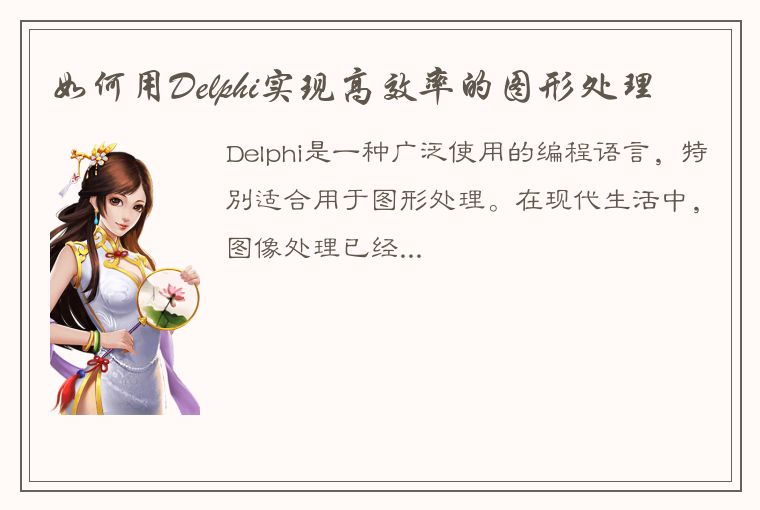Delphi是一种广泛使用的编程语言,特别适合用于图形处理。在现代生活中,图像处理已经成为了重要的技术,而Delphi可以通过结合强大的图形库来实现高效的图像处理。本文将分享如何利用Delphi实现高效率的图形处理。

一、Delphi的基础
Delphi是一种可视化的编程语言,其中包含了许多强大的源代码库和组件。Delphi可以让程序员轻松地开发Windows及其他操作系统上的程序。Delphi包括一个称为VCL(可视化组件库)的工具箱,因此您不必亲自编写许多常用的控件,如按钮、文本框或多选框等等。VCL完美地整合了Visual Basic和C ++之间的差距,使得开发图形界面程序变得十分简单。
Delphi的基本语法与其他OOP语言相似,例如Java和C#。它包括循环、条件语句、函数和过程定义等等。对于想要进一步了解Delphi的人,可以通过在线教程来进行学习。
二、图形处理
图形处理是一种将数字数据转换成具有可视化含义的图形的过程。在计算机科学领域,处理图像需要一系列算法和技术,比如图像滤波、缩放、旋转、边缘检测、傅里叶变换等等。通过这些技术,我们可以在计算机上处理和改变图像,形成我们所需要的处理结果,例如图像增强、图像修复、目标检测和分割等等。
在Delphi中,我们可以使用许多图形处理工具包和库,例如Graphics32、GDI +和OpenCV等等。这些库提供了许多图像处理算法和技术,可以使我们更加方便地开发高效的图像处理应用程序。
三、图形处理的示例
接下来,我们将提供一些示例来演示如何使用Delphi来实现图形处理的技术。
1、使用Graphics32库进行图像滤波
Graphics32是一种免费的图形处理库,它提供了很多基本的处理功能。这里我们将演示如何使用Graphics32来实现图像滤波的功能。
使用Graphics32需要先安装Graphics32库,然后在程序中添加Graphics32的单元,同时引用其包。
unit Unit1;
interface
uses
Windows, Messages, SysUtils, Variants, Classes, Graphics, Controls, Forms,
Dialogs, GR32, GR32_Image, GR32_Layers, GR32_Transforms;
type
TForm1 = class(TForm)
Image1: TImage32;
Image2: TImage32;
private
{ Private declarations }
public
{ Public declarations }
end;
var
Form1: TForm1;
implementation
{$R *.dfm}
procedure TForm1.Button1Click(Sender: TObject);
var
Bitmap32Ex1: TBitmap32Ex;
MyKernel: TKernel;
begin
Bitmap32Ex1 := TBitmap32Ex.Create;
try
Bitmap32Ex1.Assign(Image1.Bitmap);
MyKernel := TKernel.Create;
try
MyKernel.Size := 5;
SetKernel(MyKernel, 1/25); //SetKernel(kernel:TKernel; weight:Single);
Bitmap32Ex1.Convolve(MyKernel, Image2.Bitmap);
finally
MyKernel.Free;
end;
finally
Bitmap32Ex1.Free;
end;
end;
end.
上面这个的代码片段演示了如何通过载入一个图片到一个TBitmap32Ex中来执行卷积运算。将卷积的输出赋值到Image32图层,即可通过Image32控件进行显示,即可实现图像滤波的效果。
2、使用GDI+进行图像缩放
GDI +是Windows对图形和文本渲染的一个API集。在Delphi中,您可以使用GDI +库来处理图像缩放的需求。“GDI +”即“图形设备接口 ”与“加强”空间的缩写,其提供了许多高级图形处理功能。
unit Unit1;
interface
uses
Windows, Messages, SysUtils, Variants, Classes, Graphics,
Controls, Forms, Dialogs, StdCtrls;
type
TForm1 = class(TForm)
Button1: TButton;
Image1: TImage;
procedure Button1Click(Sender: TObject);
private
{ Private declarations }
public
{ Public declarations }
end;
var
Form1: TForm1;
implementation
{$R *.dfm}
uses
GDIPAPI, GDIPOBJ;
procedure TForm1.Button1Click(Sender: TObject);
const
SourceFile = 'source.jpg';
DestFile = 'zoomed.jpg';
var
Bitmap: TGPBitmap;
Width, Height: Integer;
Graphics: TGPGraphics;
DestBitmap: TGPBitmap;
DestWidth, DestHeight: Integer;
Encoder: TGUID;
EncoderParams: PGdiplusEncoderParameters;
EncoderParamsStorage: TGdiplusEncoderParameters;
begin
Bitmap := TGPBitmap.Create(SourceFile);
try
Graphics := TGPGraphics.Create;
try
Graphics.DrawImage(Bitmap, 0, 0, Bitmap.GetWidth, Bitmap.GetHeight);
Width := Bitmap.GetWidth;
Height := Bitmap.GetHeight;
DestWidth := Round(Width * 1.5);
if DestWidth > 2000 then
DestWidth := 2000; //避免图像过大
DestHeight := Round(Height * 1.5);
if DestHeight > 2000 then
DestHeight := 2000; //避免图像过大
DestBitmap := TGPBitmap.Create(DestWidth, DestHeight, PixelFormat32bppRGB);
try
Graphics.SetInterpolationMode(InterpolationModeHighQualityBicubic);
Graphics.DrawImage(DestBitmap, RectF(0, 0, DestWidth, DestHeight), RectF(0, 0, Width, Height), UnitPixel);
Encoder := EncoderJPEG;
EncoderParams := @EncoderParamsStorage;
EncoderParams.Count := 1;
EncoderParams.Parameter[0].Guid := EncoderQuality;
EncoderParams.Parameter[0].Type_ := EncoderParameterValueTypeLong;
EncoderParams.Parameter[0].NumberOfValues := 1;
EncoderParams.Parameter[0].Value := @CQuality100;
if GdipSaveImageToFile(DestBitmap, DestFile, @Encoder, EncoderParams) = Ok then
ShowMessage('已成功拼接文件');
finally
DestBitmap.Free;
end;
finally
Graphics.Free;
end;
finally
Bitmap.Free;
end;
end;
end.
上面这个的代码片段显示了如何在Delphi中使用GDI+库来进行图像处理。其中演示了如何将既有的图像进行缩放处理并生成新的缩放图。
3、使用OpenCV进行图像边缘检测
OpenCV是一种常用的计算机视觉库,提供了强大的基于图像和视频的算法。OpenCV的目标是提供一种实用、开放、高效、完整的计算机视觉库。在Delphi中,我们可以利用OpenCV来进行图像处理,例如图像增强、傅里叶变换、目标检测和边缘检测等。
以下是OpenCV库进行Canny边缘检测的基本代码:
unit Unit1;
interface
uses
Windows, Forms, SysUtils, Controls, StdCtrls, Vcl.ExtCtrls, Vcl.Graphics,
OpenCV_cxcore, OpenCV_highgui, OpenCV_imgproc, Vcl.Imaging.jpeg;
type
TForm1 = class(TForm)
Image1: TImage;
Image2: TImage;
procedure FormCreate(Sender: TObject);
private
{ Private declarations }
public
{ Public declarations }
end;
var
Form1: TForm1;
implementation
{$R *.dfm}
procedure TForm1.FormCreate(Sender: TObject);
var
Img: IplImage;
dstImage: IplImage;
begin
//读取原始图片
Img := LoadImage('lena.jpg', CV_LOAD_IMAGE_GRAYSCALE);
if Assigned(Img) then
begin
//创建一个与原始图像大小相同的图像
dstImage := cvCreateImage(cvSize(Img.Width, Img.Height), IPL_DEPTH_8U, 1);
try
//将原始图片进行边缘检测
cvCanny(Img, dstImage, 10, 50, 3);
Image1.Picture.Bitmap.Assign(IplImageToBitmap(dstImage));
finally
cvReleaseImage(dstImage);
end;
end;
end;
end.
上述代码演示了如何使用Opencv边缘检测算法处理图像。通过该算法可以将一张图像中的边缘和轮廓信息提取出来。
四、总结
如今,图形处理已经成为了许多领域的核心,例如计算机辅助设计、计算机视觉和图像识别等等。在Delphi的帮助下,我们可以轻松地开发高效的图像处理应用程序。通过掌握Delphi的基本语法和优势工具包,我们可以实现大量的图像处理技术,包括图像滤波、图像增强、边缘检测和目标检测等等。




 QQ客服专员
QQ客服专员 电话客服专员
电话客服专员